Meal prep can be a lifesaver for busy people who want to eat healthy. But who says meal prep has to be boring? Salads are a fantastic option for meal prep, offering a refreshing and healthy alternative to heavier meals. Plus, with a little planning and creativity, you can create delicious and satisfying salads that you’ll look forward to eating all week long. Learn how to meal prep salads!
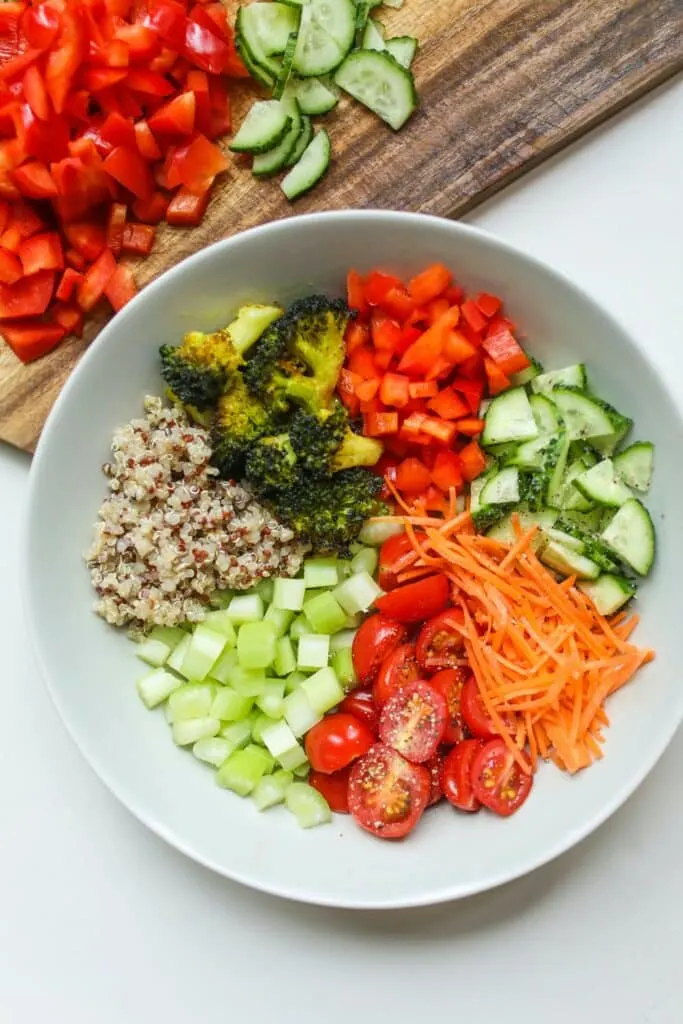
Check out these Meal Prep Containers to make your life easier!
What Are the Benefits of Meal Prep?
Meal prepping has become popular for a reason, offering benefits for busy individuals seeking healthy eating habits. Here are the key advantages of meal prepping:
1. Save Time: Imagine not scrambling every day to figure out what to eat and cook! Meal prepping eliminates the daily decision-making and cooking fatigue.
2. Eat Healthier: Meal prepping gives you control over your ingredients and portions. Choose wholesome, nutritious ingredients.
3. Control Your Budget: Planning your meals and buying ingredients in bulk translates to significant cost savings. You avoid impulse buys at grocery stores and reduce takeout spending.
4. Manage Weight: When you have healthy meals readily available, you’re less likely to resort to unhealthy snacks or takeout. Meal prepping can help you manage your weight effectively and support your fitness goals.
5. Reduce Food Waste: Planning your meals helps you buy only what you need, minimizing the risk of food spoilage and reducing food waste.
6. Boost Mood and Energy: Having ready-to-eat meals eliminates the stress of deciding what to eat, especially during busy days.
7. Encourage Variety: Meal prepping doesn’t have to be boring! It allows you to experiment with different recipes and ingredients, ensuring you get a variety of flavors and nutrients.
8. Improve Cooking Skills: Spending dedicated time on meal prep gives you an opportunity to hone your cooking skills. Try new techniques, explore different cuisines, and build confidence in the kitchen.
9. Support Mealtime Togetherness: Meal prepping is a fun activity for family and friends.
10. Achieve Personal Goals: Whether your goal is to eat healthier, manage weight, save money, or simply simplify your life, meal prepping can be a powerful tool.
Remember, meal prepping is a flexible approach. Adapt it to your preferences and lifestyle for maximum benefit. Start small and find what works best for you.
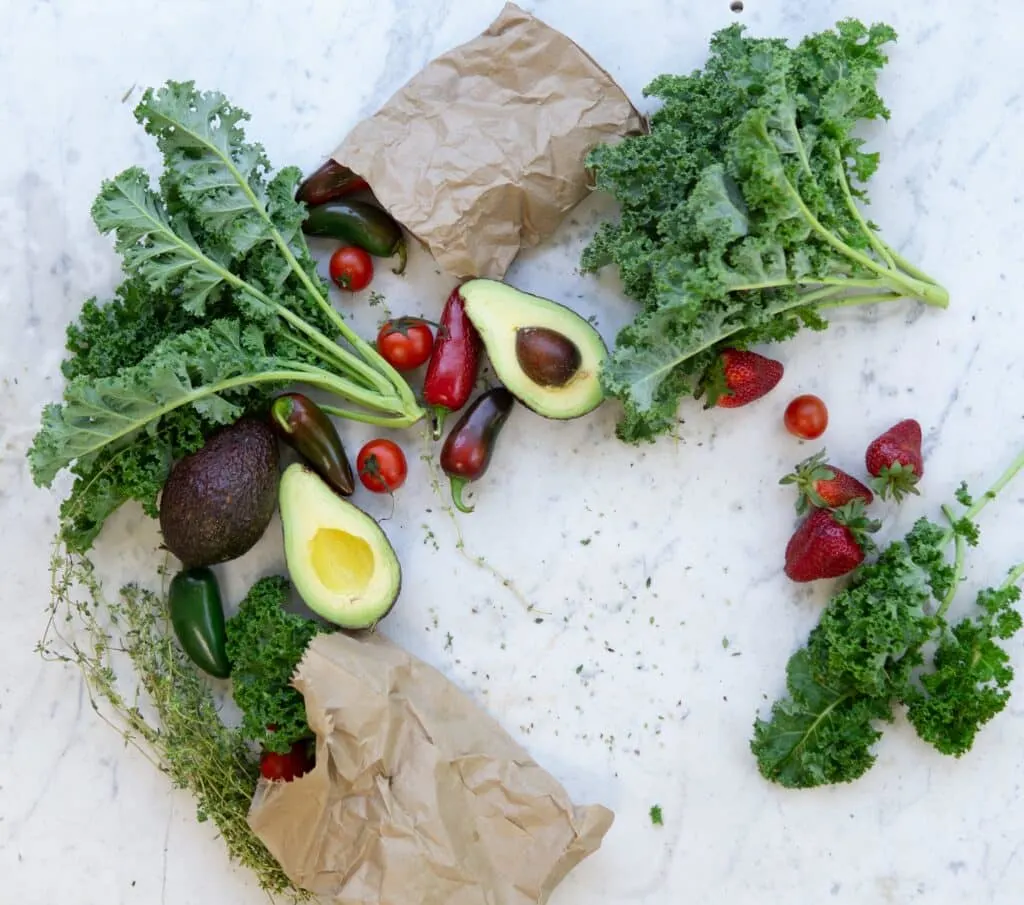
How to Meal Prep a Salad for a Week
Let’s face it, the lunch hour blues often feature wilted greens and soggy disappointment. But banish the bland from your workday!
Meal prep salads can be vibrant champions of health and flavor, ready to conquer your week with every crisp bite. Ditch the desk drawer drama and embrace a garden of goodness, prepped like a pro and bursting with potential.
Salad Strategies for Star Chefs:
Foundation Fit: Forget flimsy greens! Opt for sturdy romaine, kale, or cabbage – champions of week-long crispness.
Chop Smart: Bite-sized veggies prevent sogginess. Diced cucumbers, tomatoes, and their juicy brethren can join the party fresh upon assembly.
Layering Masterclass: Imagine your salad as a delicious lasagna. Nuts, seeds, and grains form the base, followed by veggie layers. Crisp greens go next, then protein, and lastly, the dressing – a grand finale of flavor.
Dress for Success (Without Drenching Your Greens):
Hold the soggy salad syndrome! Keep that vinaigrette or creamy concoction in a separate container, adding it only when hunger strikes. Your greens will maintain their vibrant crunch till the very last leaf.
Storage Smarts:
Airtight Mason jars are your best friends. Portion-controlled bowls and leakproof containers join the team, ensuring your garden of flavors stays fresh and organized. Label everything with the date, and voilà, your fridge becomes a pantry of prepped perfection.
A Week of Flavorful Feasts:
Mediterranean Monday: Romaine joins Kalamata olives, cherry tomatoes, cucumber, and chickpeas. Feta cheese and balsamic vinaigrette add a touch of Greek sunshine. Check out this Greek Salad!
Taco Tuesday Takeover: Romaine gets spicy with seasoned ground turkey or tofu, black beans, corn, and salsa. Avocado joins the fiesta, with cilantro lime dressing bringing the heat. Try this delicious Taco Salad!
Asian Adventure: Romaine meets shredded chicken or tofu, a rainbow of bell peppers and carrots, edamame, and crispy wonton strips. Peanut dressing ties it all together like a kung fu master.
Buddha Bowl Bliss: Quinoa takes center stage, surrounded by chickpeas, roasted veggies, creamy avocado, and tangy kimchi. Tahini dressing keeps it smooth and dreamy.
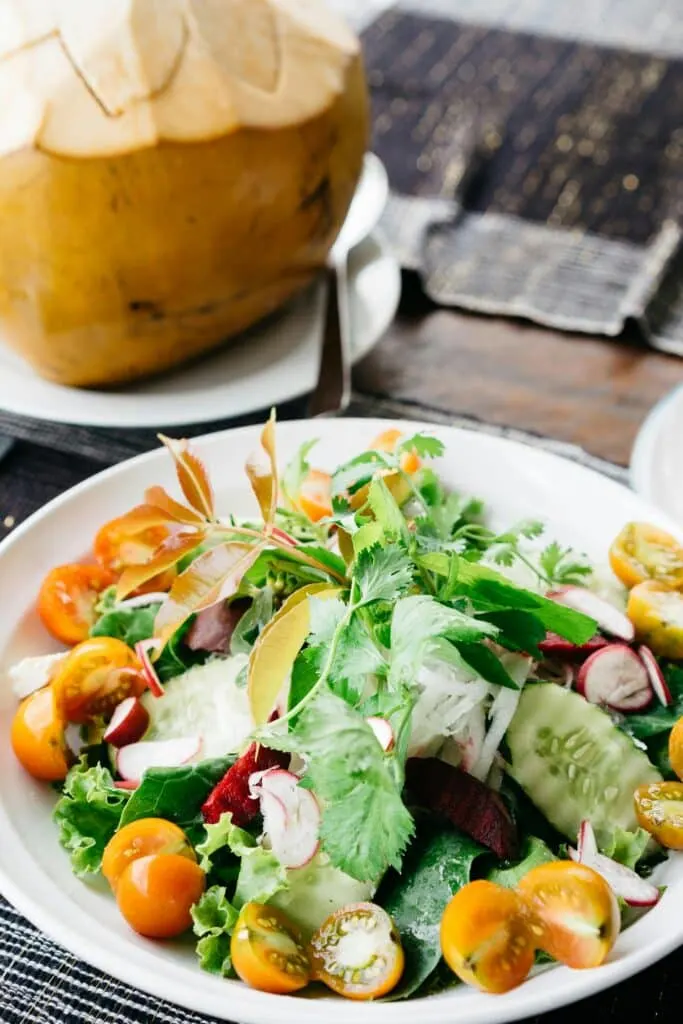
What to Avoid When Meal-prepping a Salad
Meal prepping salads is a fantastic way to stay healthy and organized throughout the week. But let’s face it, nobody enjoys a soggy, wilted salad by Wednesday. To ensure your prepped salads stay crisp, fresh, and delicious all week long, here’s what to avoid:
Soggy Greens:
Culprits: Leafy greens like spinach and romaine tend to wilt quickly.
Solution: Opt for sturdier greens like kale, swiss chard, or iceberg lettuce. These hold up better to dressing and storage.
Moisture Mayhem:
Culprits: Wet greens, juicy fruits and vegetables like tomatoes and cucumbers, and warm ingredients like cooked chicken or quinoa release moisture, making your salad soggy.
Solution: Thoroughly dry your greens with a salad spinner or paper towels. If using juicy ingredients, add them just before eating. Let cooked components cool completely before assembling your salads.
Dressing Disaster:
Culprit: Drenching your salad in dressing right away.
Solution: Store dressing on the side or in a separate compartment of your meal prep container. This prevents the greens from getting soggy and allows you to control the amount you use each day.
Storage Blunders:
Culprit: Packing your salad in an airtight container.
Solution: Choose containers with breathable vents to prevent condensation buildup, which can wilt your greens.
Flavor Fatigue:
Culprit: Sticking to the same ingredients all week.
Solution: Add variety with different textures, flavors, and proteins throughout the week. Try nuts, seeds, dried fruit, different cheeses, or a variety of chopped vegetables.
Bonus Tip:
Prep in layers: Place denser ingredients like grains and proteins on the bottom, followed by sturdier vegetables, then greens, and lastly, delicate toppings like fresh herbs or cheese. This layering helps prevent everything from getting crushed.
By following these simple tips, you can enjoy fresh, flavorful salads all week long without the fear of soggy greens or wilted lettuce. So get creative, get prepping, and enjoy the convenience and health benefits of delicious meal prep salads!
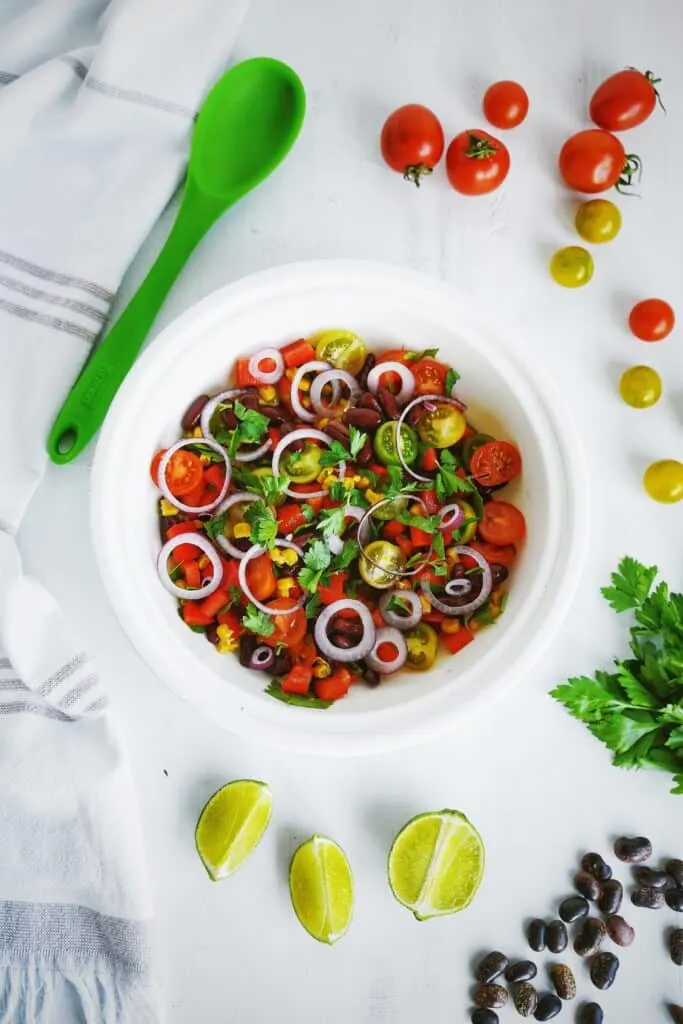
How to Batch Prep vs Ingredient Prep for Salads
Meal prepping is a tried-and-true strategy for healthy eaters and busy bees alike. But when it comes to salads, there are two main approaches: batch prepping and ingredient prepping. Each has its own set of pros and cons, so it’s important to choose the one that best fits your lifestyle and preferences.
Batch Prep: The Grab-and-Go Method
Batch prepping involves making a large batch of salad ahead of time and portioning it out into individual containers. This is a great option if you want to have quick and easy lunches all week long. Simply grab a container and go!
Pros:
Convenient: No more rushing around in the morning trying to throw together a salad.
Portion control: Each container has a controlled amount of calories and nutrients.
Variety: You can make different batches of salad throughout the week to keep things interesting.
Cons:
Potential for wilting: Some ingredients, like lettuce, can wilt if stored for too long.
Limited flexibility: You’re stuck with whatever you put in the salad at the beginning of the week.
Can get boring: Eating the same salad every day can get old after a while.
Ingredient Prep: The Mix-and-Match Approach
Ingredient prepping involves washing, chopping, and cooking the ingredients for your salads, but not actually assembling them. This gives you more flexibility to create different salads throughout the week.
Pros:
Variety: You can mix and match ingredients to create endless salad combinations.
Freshness: Ingredients stay fresh longer when stored separately.
No waste: You can use up leftover ingredients for other meals.
Cons:
Takes more time: Ingredient prepping can take longer than batch prepping.
Requires planning: You need to think ahead about what you want to eat each day.
More dishes: You’ll have more dishes to wash since you’re not assembling the salads in advance.
Ultimately, the best way to prep your salads is the way that works best for you. If you’re looking for convenience, batch prepping is a great option. If you prefer variety and flexibility, ingredient prepping is the way to go.
Here are some additional tips for prepping your salads:
Use airtight containers to store your prepped ingredients or salads.
Wash your lettuce just before eating it to prevent wilting.
Add dressing to your salad just before eating it.
Get creative with your ingredients! There are endless possibilities for delicious and healthy salads.
Best Veggies to Use For Meal Prepping Salads
Meal prepping salads is a fantastic way to stay healthy and organized during the week. But not all veggies are created equal when it comes to holding up in the fridge for a few days. So, what are the best veggies to use for meal-prep salads?
The Sturdy Stalwarts: Greens That Last
The foundation of any great salad is a bed of strong greens. These leafy heroes will maintain their crunch and vibrancy for several days, making them ideal for meal prep. Here are some top picks:
- Kale: This nutrient powerhouse is tough and versatile, holding up well to dressings and other toppings.
- Romaine lettuce: A classic choice, romaine lettuce offers a crisp, neutral flavor that pairs well with many ingredients.
- Iceberg lettuce: Similar to romaine, iceberg lettuce provides a sturdy base and a refreshing crunch.
- Cabbage: Shredded cabbage adds a satisfying chew and a touch of sweetness to salads.
- Arugula: This peppery green adds a bit of bite and pairs well with Mediterranean flavors.
Crunchy Companions: Veggies That Stay Vibrant
Don’t stop at just greens! These additional veggies will keep your meal-prep salads colorful and delicious throughout the week:
Bell peppers: Available in a variety of colors and flavors, bell peppers add sweetness and crunch to any salad.
Cherry tomatoes: Leave them whole for pops of juicy sweetness, or halve them for a burst of flavor.
Shredded carrots: A classic salad addition, carrots offer a touch of sweetness and brighten up any bowl.
Cucumbers: While they do tend to soften slightly over time, cucumbers add a refreshing coolness to salads.
Radishes: These spicy little gems add a peppery kick and vibrant color to your meal-prep creations.
Snap peas: Crunchy and sweet, snap peas are a fun and healthy addition to any salad.
Check out how to meal prep eggs as well!
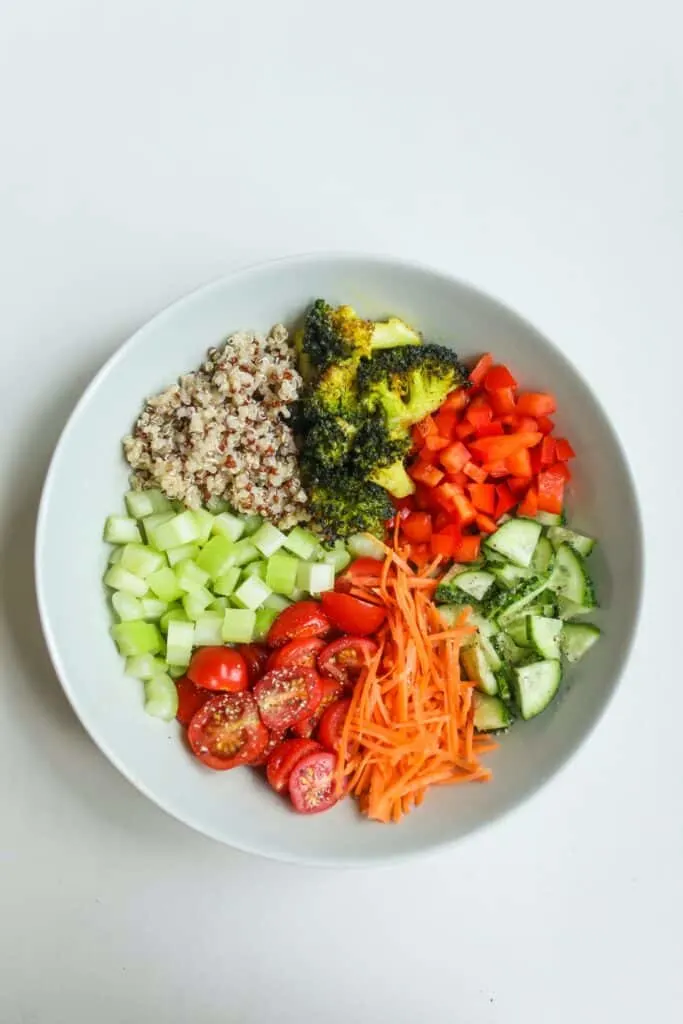
Frequently Asked Questions (FAQs)
To preserve salad for meal prep, store it in an airtight container in the fridge, and keep dressing separate to prevent sogginess.
Layer veggies and protein in airtight containers, and keep dressing separate. Build 5 salads, store for up to 4 days, and add dressing and crunch before eating!
Up to 4 days without watery stuff, 5 days with! Store dressing separately for a fresh crunch.
Store greens in airtight containers with paper towels to absorb moisture; keep dressings and wet ingredients separate.
You May Also Like
- Microwave Creamy Oatmeal
- Microwave Popcorn Without Burning
- Vegan Mug Brownie
- Defrosting Seafood in the Microwave
- How to Reheat Shrimp in the Microwave
- How to Reheat Salmon in the Microwave
If you enjoyed this post about how to meal prep salads, please leave a comment!
